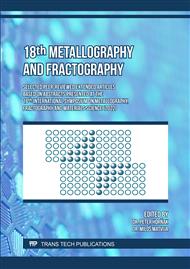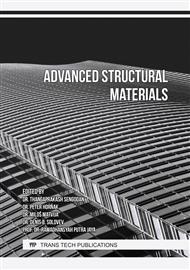[1]
C. Pare, Bronze and the Bronze Age, in: Metals Make The World Go Round, C. Pare (Ed.), 2000, 1-38, Oxbow Books, Oxford.
Google Scholar
[2]
B. Höppner, M. Bartelheim, M. Huijsmans, R. Krauss, K.-P. Martinek, E. Pernicka, R. Schwab, Prehistoric copper production in the Inn Valley (Austria), and the earliest copper in Central Europe, Archaeometry 47, 2, (2005), 293-315.
DOI: 10.1111/j.1475-4754.2005.00203.x
Google Scholar
[3]
K.-P. Martinek, W. Sydow, Frühbronzezeitliche Kupfermetallurgie im Unterinntal (Nordtirol), Der Anschnitt, Beiheft 17 (2004) 199-211.
Google Scholar
[4]
R. F. Tylecote, A History of Metallurgy, The Metals Society, Mid County Press London, 1976.
Google Scholar
[5]
E. Pernicka, J. Lutz, T. Stöllner, Bronze age copper produced at Mitterberg, Austria, and its distribution, Archaeologia Austriaca, by Österreichische Akademie der Wissenschaften, Wien, 100 (2016) 19-55.
DOI: 10.1553/archaeologia100s19
Google Scholar
[6]
H. Herdits, Die ostalpine bronzezeitliche Kupfererzeugung im überregionalen Vergleich am Grundbeispiel eines Hüttenplatzes in Mühlbach/Sbg., Dissertation an der Universität Wien, 2017.
Google Scholar
[7]
R. Haubner, Die prähistorische Kupfermetallurgie – allgemeine Betrachtungen, BHM Berg- und Hüttenmännische Monatshefte, 166 (2021) 343-351.
DOI: 10.1007/s00501-020-01056-0
Google Scholar
[8]
R. Haubner, F. Ertl, S. Strobl, Examinations of a Bronze Ingot Made of Fahlore, Practical Metallography, 54 (2017) 107-117.
DOI: 10.3139/147.110446
Google Scholar
[9]
J. D. Muhly, Sources of Tin and the Beginnings of Bronze Metallurgy, American Journal of Archaeology, 89 (1985) 275-291.
DOI: 10.2307/504330
Google Scholar
[10]
I. Baranyi, Betrachtungen über die Herkunft des Zinns in der Bronzezeit, carolinea, 58 (2000) 115-124.
Google Scholar
[11]
H. Herdits, J. Keen, M. Steinberger, Wie kommt das Zinn in die Bronze? Ein Beitrag zur experimentellen Archäologie, Archäologie Österreichs, 6 (1995) 78-85.
Google Scholar
[12]
T. Young, S. Taylor, 'Wolf rahm': archaeological evidence for the veracity of an old term, Historical Metallurgy 49 (2015) 96-109.
Google Scholar
[13]
H. Louis, Metallurgy of Tin, McGraw-Hill book Company, 1911.
Google Scholar
[14]
P. Wagner, Die mineralogisch-geologische Durchforschung Sachsens in ihrer geschichtlichen Entwickelung, Sitzungsberichte und Abhandlungen der Naturwissenschaftlichen Gesellschaft Isis in Dresden, (1902) 63-128.
Google Scholar
[15]
Georgius Agricola, in: De Natura Fossilium, 1546.
Google Scholar
[16]
E. Lassner, W.D. Schubert, The history of tungsten (Wolfram), ITIA Newsletter, June (2005), 6-11.
Google Scholar
[17]
T. Rehren, The Trewhiddle Tungsten Bloom, ITIA Newsletter, June (2005), 2-5.
Google Scholar



